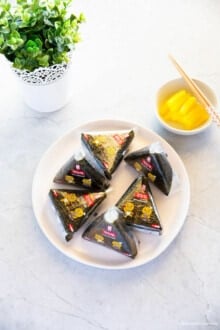The ultimate Korean steamed egg guide. How to make Korean steamed egg in three different ways!
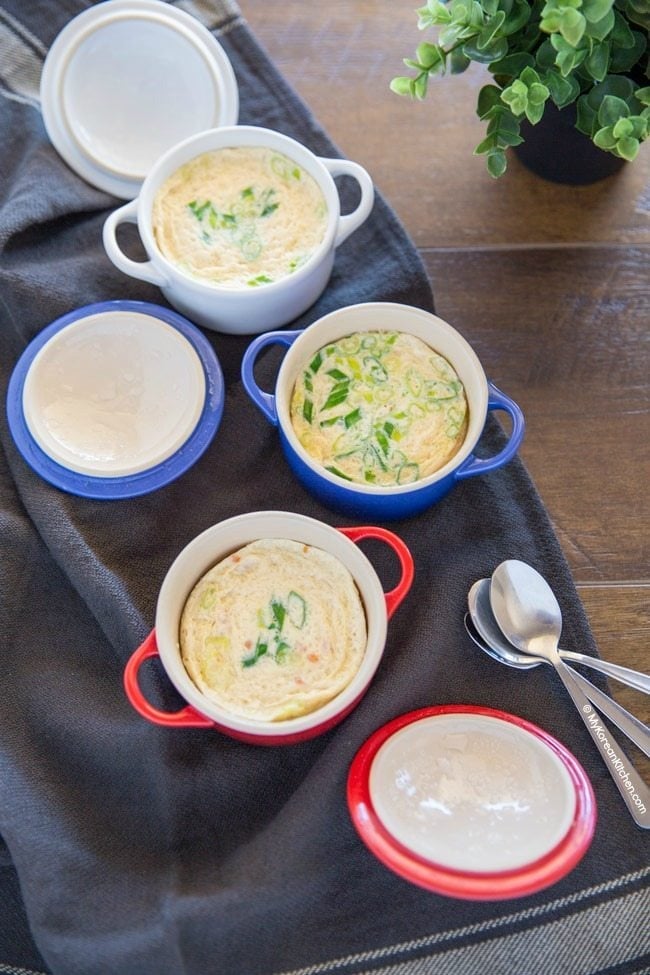
Korean steamed egg (Gyeran Jim, 계란찜) is a popular Korean side dish. It somewhat resembles an egg soufflé but it typically doesn’t include dairy products and it is steamed instead of being baked.
It has a really nice pudding like texture and is slightly salty and savory. Just what every Korean kid (big or small) would love to eat with their hot steamed rice.
It is also a popular baby food. But obviously it would then be made a lot plainer.
I certainly enjoyed eating these eggs a lot while growing up. My mom would make them a few times a week.
Nowadays, I hear some Korean BBQ restaurants (in Korea) serve this steamed egg as a complimentary side dish when you order a bowl of rice after you order the Korean BBQ as a main meal. How cool is that? 🙂
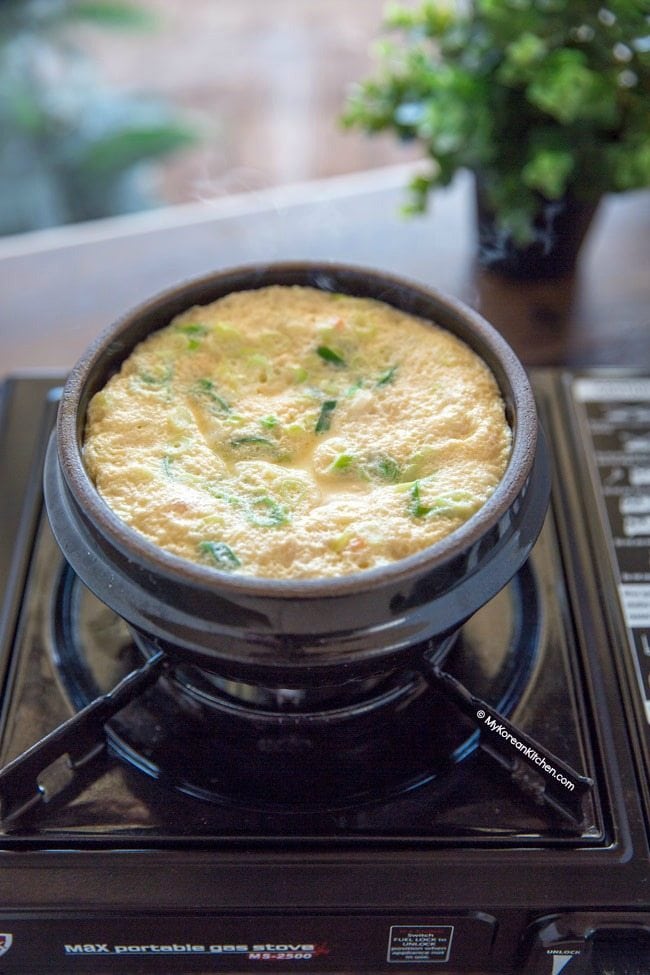
Traditional Korean steamed egg is made in a Korean hot stone bowl called Ttukbaegi (뚝배기) and people can share the steamed egg from this pot.
When I originally shared my steamed egg recipe back in 2007, my eggs were cooked in a small ramekin.
I found that this was more practical and easier to serve without upsetting everyone about who ate the most of egg!
Over the years, I also learnt that some Koreans use a microwave to make Korean steamed egg too. As you can imagine, this method is very easy, quick and convenient!
So in today’s recipe, I will show you how to cook Korean steamed egg in three different ways. If you try them all out, tell us which methods you liked the most.
Enjoy!
P.S. If you like Korean steamed egg, you might also like to try my Korean egg bread and Korean egg roll recipe.
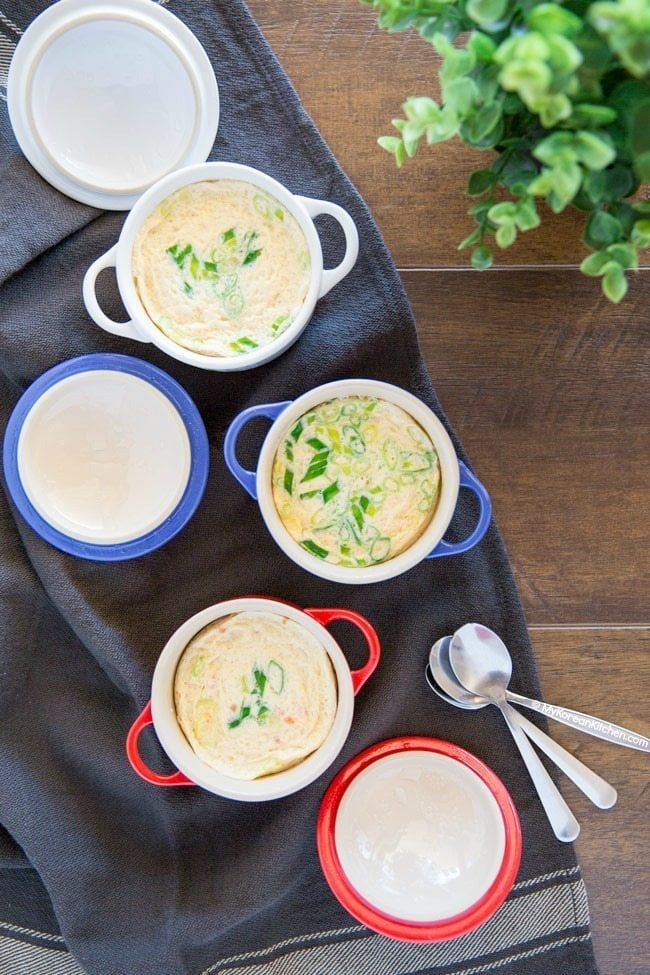
Ingredients for Korean Steamed Egg, 3 to 4 servings
- 6 large eggs
- 20 g / 0.7 ounces dried sea kelp (kombu)
- 1 and 1/2 cups water
- 1 tsp anchovy sauce
- 10 g / 0.35 ounces green onion, finely chopped
- 20 g / 0.7 ounces carrot, finely chopped
- Sesame oil
*For a variation, you can add other kinds of vegetables and even add some meat (e.g. shrimp is popular).
** 1 Tbsp = 15 ml, 1 Cup = 250 ml
How to Prepare Korean Steamed Egg
1. Soak the dried sea kelp in a bowl of water for 15 minutes.
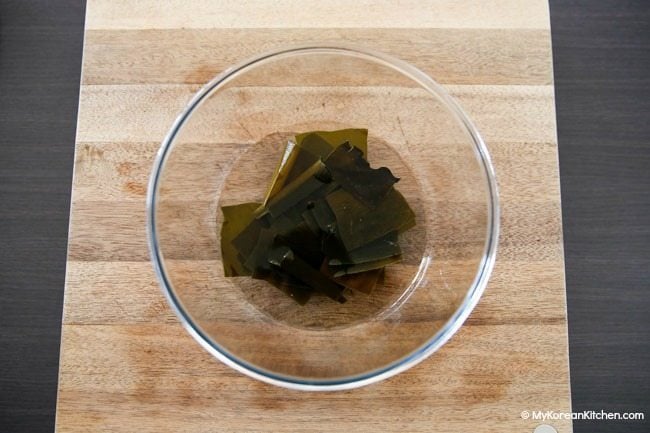
2. Beat the eggs and strain once to remove any stringy bits such as chalazae.
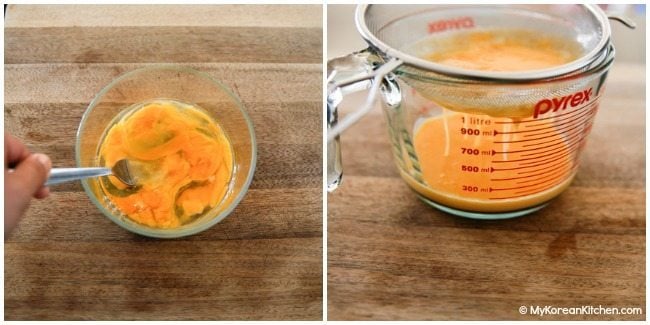
3. Discard the dried sea kelp then add the remaining water (from step 1) into the beaten egg bowl (step 2). Add the anchovy sauce, green onion, and carrot. Mix them well. Set aside.
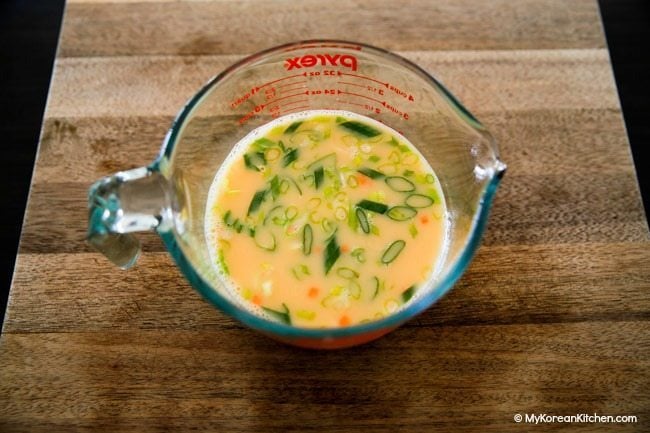
How to Cook Korean Steamed Egg in a Microwave (Modern Korean Style)
1. Drop a small dose of sesame oil into each small heat resistant bowl (e.g.ramekin or mini casserole pot). Brush the oil around to cover the inside. This will minimize the egg sticking into the bowl. Also, it will add a nice nutty aroma and flavor.
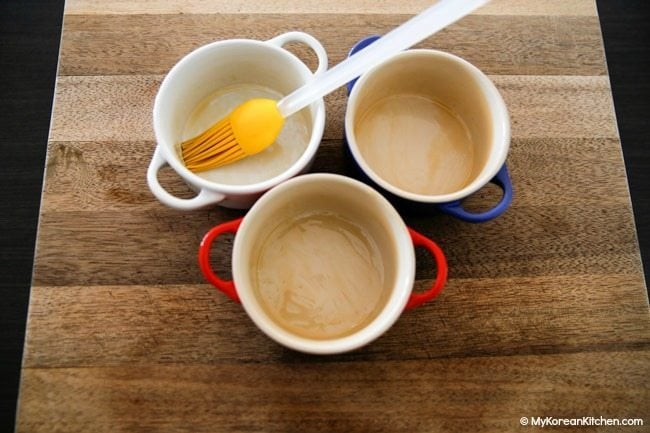
2. Pour the egg mixture into the small heat resistant bowls (up to 80% of the bowl) and cover the bowl with a small lid or cling wrap.
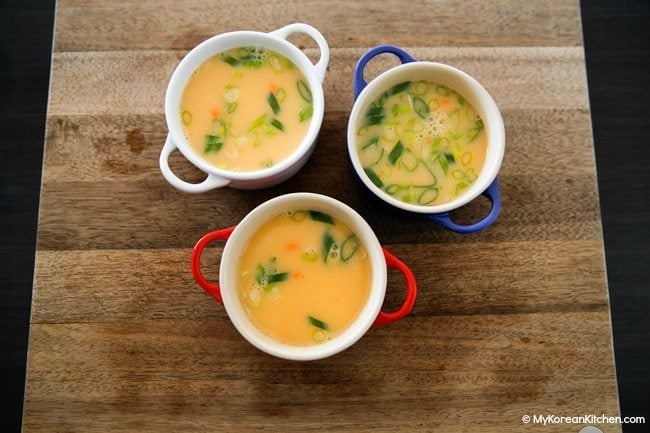
3. Place the bowls into the microwave and cook the egg for 5 minutes. (This may vary depending on your microwave.)
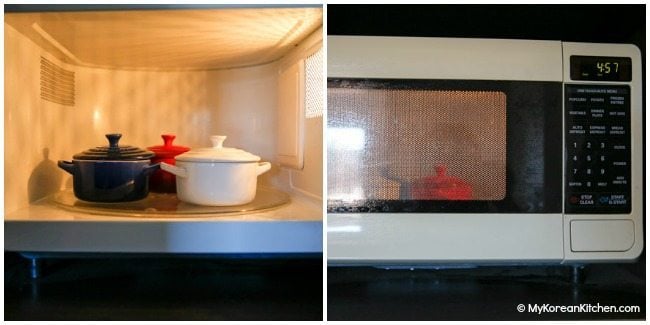
4. When the egg is cooked, remove from the microwave and serve.
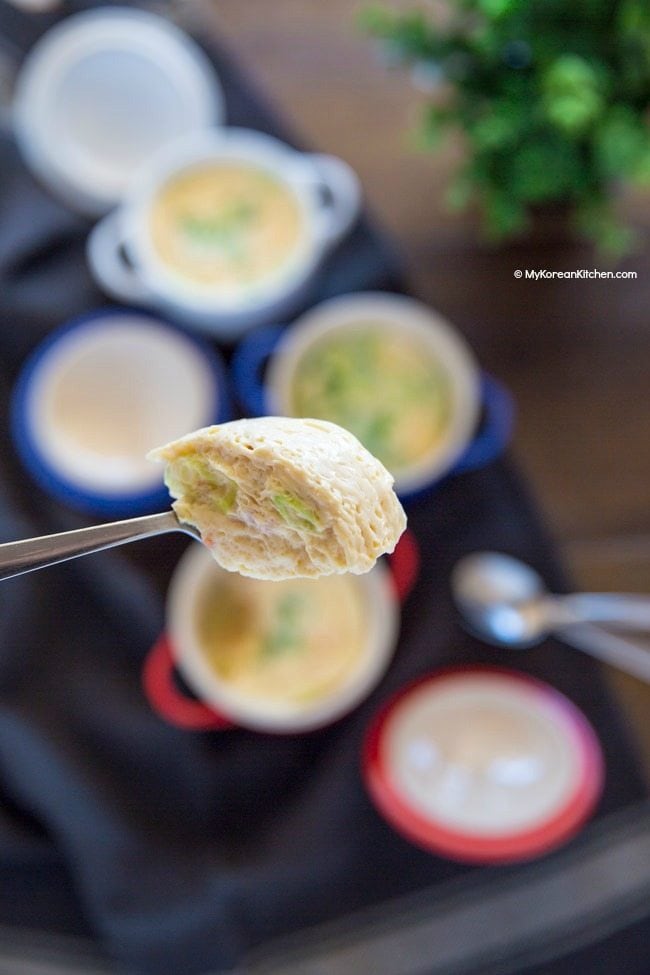
How to Cook Korean Steamed Egg in a Steamer (Japanese Chawanmushi Style)
1. Drop a small dose of sesame oil into each small heat resistant bowl (e.g.ramekin). Brush the oil around to cover the inside. This will minimize the egg sticking into the bowl. Also, it will add a nice nutty aroma and flavor.
2. Pour the egg mixture into the small heat resistant bowls (up to 80% of the bowl) and cover the bowl with cling wrap or aluminium foil.
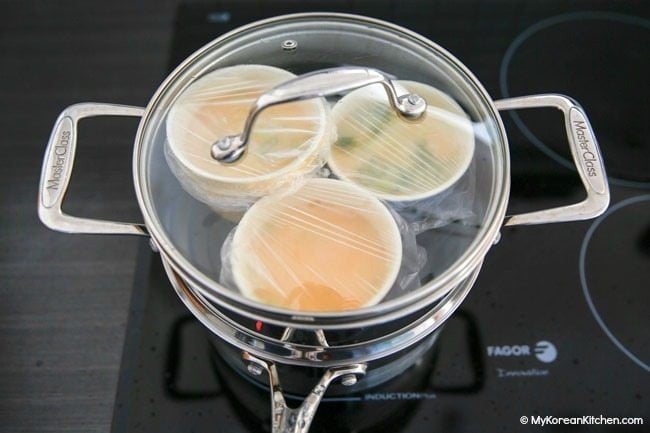
3. Boil some water on high heat in a steamer pot. When the water starts to rolling boil, place the egg filled bowls inside the steamer. Lower the heat to medium to low, and steam the bowls until the egg is cooked (about 15 to 20 minutes). Remove from the heat and serve.

How to Cook Korean Steamed Egg in a Korean Hot Stone Bowl (Ttukbaegi, Traditional Korean Style)
1. Drop a small dose of sesame oil into the hot stone bowl (ttukbaegi). Brush the oil around to cover the inside. This will minimize the egg sticking into the bowl. Also, it will add a nice nutty aroma and flavor.
2. Pour the egg mixture into the bowl (up to 80% of the bowl).
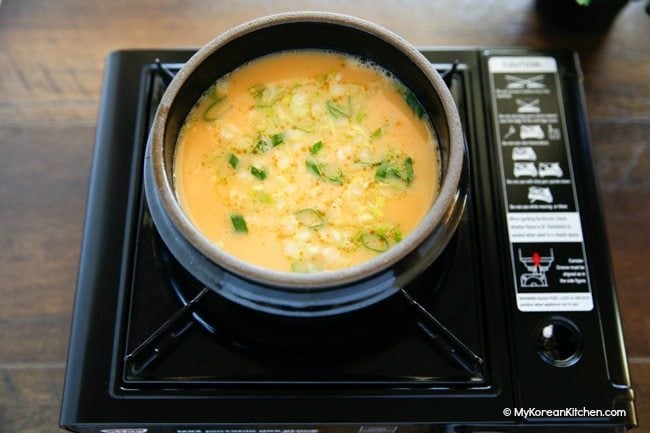
3. Boil the bowl over medium high heat for about 3 minutes then reduce the heat to medium low to low. Cover with a lid and simmer until the egg is cooked (about 10 to 15 minutes). Serve.
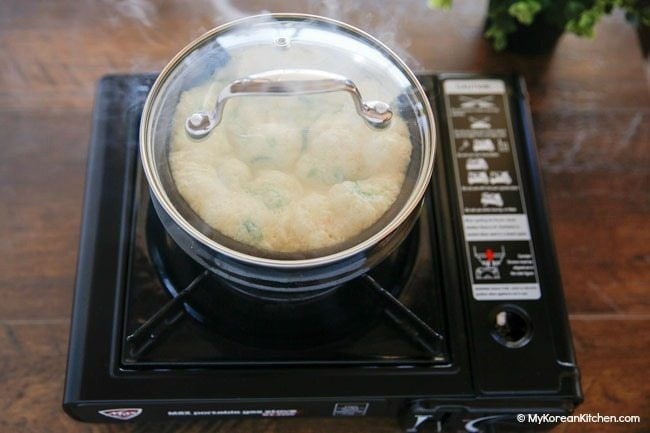

Korean Steamed Egg (Gyeran Jjim)
Ingredients
- 6 large eggs
- 20 g dried sea kelp (0.7 ounces), (kombu)
- 1 1/2 cup water
- 1 tsp anchovy sauce
- 10 g green onion (0.35 ounces), finely chopped
- 20 g carrot (0.7 ounces), finely chopped
- sesame oil
Instructions
HOW TO PREPARE KOREAN STEAMED EGG
- Soak the dried sea kelp in a bowl of water for 15 minutes.
- Beat the eggs and strain once to remove any stringy bits such as chalazae.
- Discard the dried sea kelp then add the remaining water (from step 1) into the beaten egg bowl (step 2). Add the anchovy sauce, green onion, and carrot. Mix them well. Set aside.
HOW TO COOK KOREAN STEAMED EGG IN A MICROWAVE (MODERN KOREAN STYLE)
- Drop a small dose of sesame oil into each small heat resistant bowl (e.g.ramekin or mini casserole pot). Brush the oil around to cover the inside. This will minimize the egg sticking into the bowl. Also, it will add a nice nutty aroma and flavor.
- Pour the egg mixture into the small heat resistant bowls (up to 80% of the bowl) and cover the bowl with a small lid or cling wrap.
- Place the bowls into the microwave and cook the egg for 5 minutes. (This may vary depending on your microwave.)
- When the egg is cooked, remove from the microwave and serve.
HOW TO COOK KOREAN STEAMED EGG IN A STEAMER (JAPANESE CHAWANMUSHI STYLE)
- Drop a small dose of sesame oil into each small heat resistant bowl (e.g.ramekin). Brush the oil around to cover the inside. This will minimize the egg sticking into the bowl. Also, it will add a nice nutty aroma and flavor.
- Pour the egg mixture into the small heat resistant bowls (up to 80% of the bowl) and cover the bowl with cling wrap or aluminium foil.
- Boil some water on high heat in a steamer pot. When the water starts to rolling boil, place the egg filled bowls inside the steamer. Lower the heat to medium to low, and steam the bowls until the egg is cooked (about 15 to 20 minutes). Remove from the heat and serve.
HOW TO COOK KOREAN STEAMED EGG IN A KOREAN HOT STONE BOWL (TTUKBAEGI, TRADITIONAL KOREAN STYLE)
- Drop a small dose of sesame oil into the hot stone bowl (ttukbaegi). Brush the oil around to cover the inside. This will minimize the egg sticking into the bowl. Also, it will add a nice nutty aroma and flavor.
- Pour the egg mixture into the bowl (up to 80% of the bowl).
- Boil the bowl over medium high heat for about 3 minutes then reduce the heat to medium low to low. Cover with a lid and simmer until the egg is cooked (about 10 to 15 minutes). Serve.
Notes
Nutrition Info (per serving)
The nutrition information shown is an estimate provided by an online nutrition calculator. It should not be considered a substitute for a professional nutritionist’s advice.


